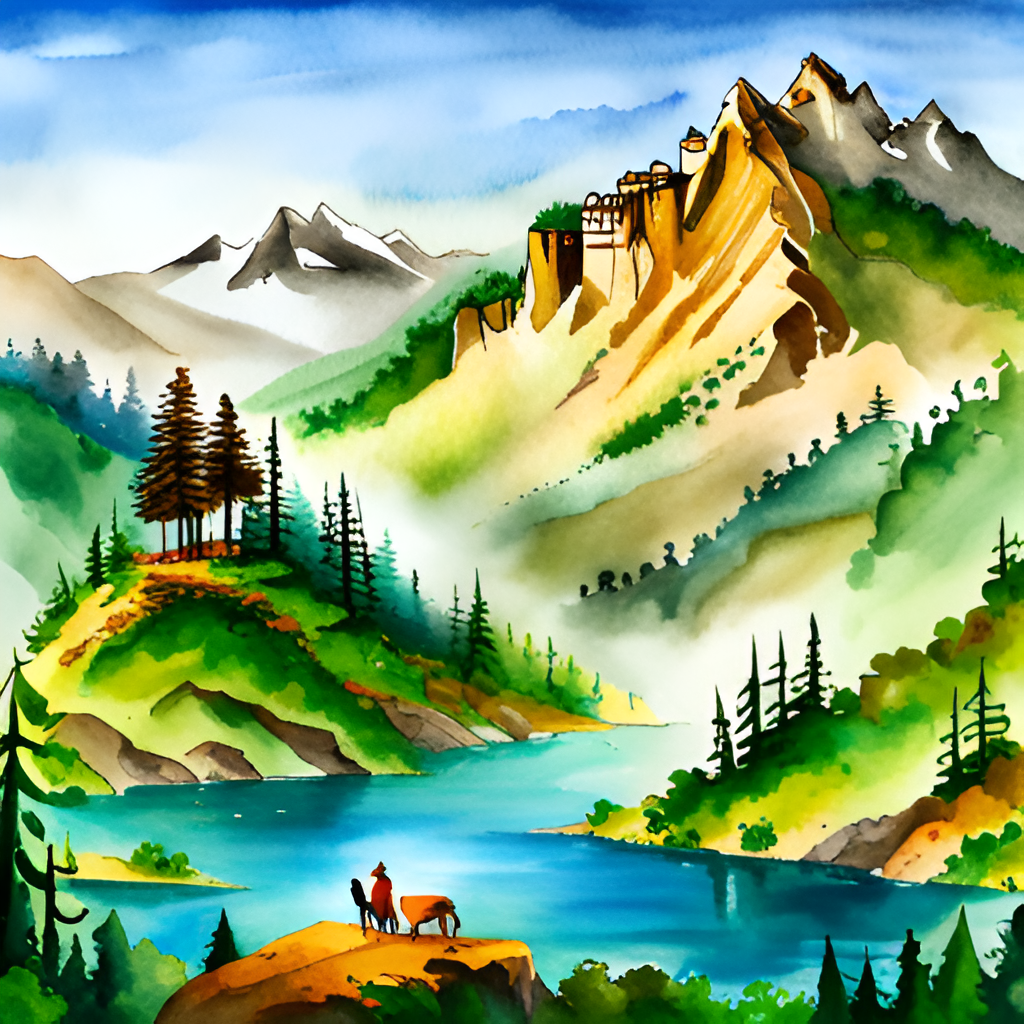The Northern Mountains, also known as the Himalayas, are a majestic mountain range that stretches across several countries, including India, Nepal, Bhutan, China (Tibet), and Pakistan. Here are the key characteristics of the Northern Mountains:
- Geographic Extent: The Northern Mountains cover a vast area, spanning approximately 2,400 kilometers (1,500 miles) from west to east. They begin in the northwest near the Hindu Kush mountain range in Afghanistan and extend eastward towards the Brahmaputra River in northeastern India.
- Highest Peaks: The Himalayas are home to some of the world’s highest peaks, including Mount Everest, the highest peak on Earth at 8,848 meters (29,029 feet) above sea level. Other prominent peaks in the region include Kanchenjunga, Makalu, Lhotse, and Annpurna.
- The Himachal and Uttarakhand Himalayas are specific regions within the larger Himalayan mountain range. Here’s some information about each of these regions:
THE HIMANCHAL AND UTTARAKHAND HIMALAYAS:
Himachal Himalayas
The Himachal Himalayas is a region in northern India that covers the state of Himachal Pradesh. It is located in the western part of the Himalayan range. Here are some key features of the Himachal Himalayas:
- Geographical Features: The Himachal Himalayas are characterized by a series of parallel mountain ranges, including the Dhauladhar Range, Pir Panjal Range, and the Great Himalayan Range. The Great Himalayan Range is the highest and most prominent range in this region, with peaks exceeding 6,000 meters (19,685 feet) in elevation.
- Hill Stations: The Himachal Himalayas are known for their picturesque hill stations, which are popular tourist destinations. Shimla, Manali, Dharamshala, and Dalhousie are among the well-known hill stations in the region. These towns offer breathtaking views, pleasant weather, and opportunities for trekking and adventure sports.
- Glaciers and Rivers: The Himachal Himalayas have several glaciers, including the Beas Kund Glacier, Chandra Taal Glacier, and Parvati Glacier. These glaciers feed numerous rivers such as the Beas, Chenab, Ravi, and Sutlej, which provide water for irrigation, hydroelectric power generation, and other economic activities.
- Wildlife and Biodiversity: The region is home to diverse flora and fauna. Himachal Pradesh has several national parks and wildlife sanctuaries, including Great Himalayan National Park, Pin Valley National Park, and Kufri Wildlife Sanctuary. These protected areas preserve the habitat of various species, including snow leopards, Himalayan black bears, musk deer, and numerous bird species.
- 7 Unique Ways to Savor Onam’s Special Traditions

- Angkor Wat – The Largest Hindu-Buddhist Temple in the World

- Art and Culture of India: A Tapestry of Diversity

Uttarakhand Himalayas:
The Uttarakhand Himalayas is a region in northern India that encompasses the state of Uttarakhand. It lies in the central part of the Himalayan range. Here are some notable features of the Uttarakhand Himalayas:
- Geographical Features: The Uttarakhand Himalayas comprise several mountain ranges, including the Garhwal Himalayas and Kumaon Himalayas. The Garhwal Himalayas, in particular, are known for their high peaks, including Nanda Devi, Kamet, and Trishul.
- Pilgrimage Sites: The Uttarakhand Himalayas are renowned for their spiritual and pilgrimage sites. The Char Dham Yatra, which includes the holy shrines of Yamunotri, Gangotri, Kedarnath, and Badrinath, is a significant pilgrimage route in the region. Thousands of devotees undertake this sacred journey each year.
- Glaciers and Rivers: The Uttarakhand Himalayas are home to several glaciers, including Gangotri Glacier, Milam Glacier, and Pindari Glacier. These glaciers are the source of major rivers like the Ganges, Yamuna, and Alaknanda, which hold immense religious and cultural significance in India.
- Valley of Flowers: The Valley of Flowers National Park, located in the Uttarakhand Himalayas, is a UNESCO World Heritage Site. It is known for its stunning alpine meadows and a wide variety of wildflowers that bloom during the summer months, creating a vibrant and picturesque landscape.
- Adventure Sports: The Uttarakhand Himalayas offer numerous opportunities for adventure sports. Popular activities include trekking, mountaineering, river rafting, skiing, and wildlife safaris. Auli and Munsiyari are renowned for their ski slopes, while Rishikesh is a popular destination for river rafting.
The Himachal and Uttarakhand Himalayas are both characterized by their awe-inspiring mountain ranges, glaciers, rivers, and cultural and natural attractions. These regions attract visitors with their scenic beauty, adventure opportunities, and spiritual significance.
DARJILING AND SIKKIM HIMALAYAS:
Darjeeling and Sikkim are two regions located in the eastern part of the Himalayas. Here is some information about Darjeeling and Sikkim Himalayas:
Darjeeling
Darjeeling is a town in the Indian state of West Bengal and is known for its picturesque beauty, tea plantations, and its location in the Lesser Himalayas. Some key points about Darjeeling and its Himalayan surroundings include:
- Tea Plantations: Darjeeling is famous for its tea industry, and its tea plantations are renowned for producing high-quality Darjeeling tea. The region’s cool climate, fertile soil, and elevation contribute to the unique flavor and aroma of Darjeeling tea.
- UNESCO World Heritage Site: The Darjeeling Himalayan Railway, also known as the “Toy Train,” is a narrow-gauge railway that is recognized as a UNESCO World Heritage Site. This heritage railway offers scenic rides through the hilly terrain, offering breathtaking views of the Himalayan mountains and valleys.
- Kanchenjunga: The third highest peak in the world, Mount Kanchenjunga, lies near Darjeeling on the border between India and Nepal. The mountain is revered and holds cultural and religious significance for the local communities. Views of Kanchenjunga can be enjoyed from various viewpoints in Darjeeling.
Sikkim
Sikkim is a northeastern state of India and is situated in the eastern part of the Himalayas. It is known for its stunning landscapes, biodiversity, and rich cultural heritage. Some notable aspects of the Sikkim Himalayas are:
- Kanchenjunga National Park: Sikkim is home to the Kanchenjunga National Park, a UNESCO World Heritage Site and one of the highest national parks in the world. It covers a significant portion of the Eastern Himalayas and is renowned for its biodiversity, including rare and endangered species like the snow leopard and red panda.
- Buddhist Monasteries: Sikkim has a strong Buddhist influence, and the region is dotted with numerous monasteries and gompas. The Rumtek Monastery, Pemayangtse Monastery, and Tashiding Monastery are among the prominent Buddhist sites in Sikkim, known for their architectural beauty and spiritual significance.
- Trekking and Mountaineering: The Sikkim Himalayas offer excellent opportunities for trekking and mountaineering enthusiasts. Popular treks include the Singalila Ridge Trek, Goecha La Trek, and Dzongri Trek, which provide stunning views of the Himalayan peaks, valleys, and alpine meadows.
- Hot Springs and Lakes: Sikkim is known for its natural hot springs, which are believed to have therapeutic properties. The Yumthang Valley and Gurudongmar Lake are scenic locations where visitors can enjoy the beauty of high-altitude lakes surrounded by snow-capped mountains.
- Cultural Festivals: Sikkim celebrates a range of vibrant cultural festivals that showcase the state’s diverse ethnic communities. The most famous festival is Losar, the Tibetan New Year, which is celebrated with colorful masked dances, music, and other cultural performances.
Both Darjeeling and Sikkim offer unique experiences in the Himalayas, with their stunning landscapes, cultural heritage, and opportunities for adventure and exploration.





